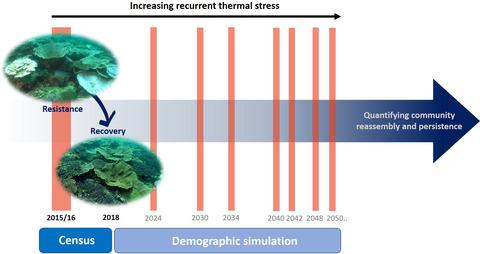当前位置:
X-MOL 学术
›
J. Anim. Ecol.
›
论文详情
Our official English website, www.x-mol.net, welcomes your
feedback! (Note: you will need to create a separate account there.)
The projected degradation of subtropical coral assemblages by recurrent thermal stress
Journal of Animal Ecology ( IF 3.5 ) Pub Date : 2020-10-09 , DOI: 10.1111/1365-2656.13340 James Cant 1 , Roberto Salguero-Gómez 2, 3, 4 , Sun W Kim 5 , Carrie A Sims 5 , Brigitte Sommer 6 , Maxime Brooks 1 , Hamish A Malcolm 7 , John M Pandolfi 5 , Maria Beger 1, 3
Journal of Animal Ecology ( IF 3.5 ) Pub Date : 2020-10-09 , DOI: 10.1111/1365-2656.13340 James Cant 1 , Roberto Salguero-Gómez 2, 3, 4 , Sun W Kim 5 , Carrie A Sims 5 , Brigitte Sommer 6 , Maxime Brooks 1 , Hamish A Malcolm 7 , John M Pandolfi 5 , Maria Beger 1, 3
Affiliation

|
Subtropical coral assemblages are threatened by similar extreme thermal stress events to their tropical counterparts. Yet, the mid- and long-term thermal stress responses of corals in subtropical environments remain largely unquantified, limiting our capacity to predict their future viability. The annual survival, growth and recruitment of 311 individual corals within the Solitary Islands Marine Park (Australia) was recorded over a three year period (2016 - 2018), including the 2015/16 thermal stress event. This data was used to parameterise Integral Projection Models quantifying the effect of thermal stress within a subtropical coral assemblage. Stochastic simulations were also applied to evaluate the implications of recurrent thermal stress scenarios predicted by four different Representative Concentration Pathways. We report differential shifts in population growth rates (λ) among coral populations during both stress and non-stress periods, confirming contrasting bleaching responses amongst taxa. However, even during non-stress periods, the observed dynamics for all taxa were unable to maintain current community composition, highlighting the need for external recruitment sources to support the community structure. Across all coral taxa, projected stochastic growth rates (λs ) were found to be lowest under higher emissions scenarios. Correspondingly, predicted increases in recurrent thermal stress regimes may accelerate the loss of coral coverage, species diversity, and structural complexity within subtropical regions. We suggest that these trends are primarily due to the susceptibility of subtropical specialists and endemic species, such as Pocillopora aliciae, to thermal stress. Similarly, the viability of many tropical coral populations at higher latitudes is highly dependent on the persistence of up-current tropical systems. As such, the inherent dynamics of subtropical coral populations appear unable to support their future persistence under unprecedented thermal disturbance scenarios.
中文翻译:

反复热应力对亚热带珊瑚群的预计退化
亚热带珊瑚组合受到与热带珊瑚类似的极端热应力事件的威胁。然而,亚热带环境中珊瑚的中长期热应激反应在很大程度上仍未量化,这限制了我们预测其未来生存能力的能力。在三年期间(2016 年至 2018 年),包括 2015/16 年热应激事件,记录了孤岛海洋公园(澳大利亚)内 311 只珊瑚的年度存活、生长和补充情况。该数据用于参数化积分投影模型,量化亚热带珊瑚组合内热应力的影响。还应用随机模拟来评估由四种不同的代表性浓度途径预测的复发性热应力情景的影响。我们报告了压力和非压力期间珊瑚种群的种群增长率 (λ) 的差异变化,证实了分类群之间的对比漂白反应。然而,即使在非压力时期,观察到的所有分类群的动态也无法维持当前的群落组成,突出了外部招募来源来支持群落结构的必要性。在所有珊瑚分类群中,预计随机增长率 (λs) 在较高排放情景下最低。相应地,反复热应力状态的预测增加可能会加速亚热带地区珊瑚覆盖范围、物种多样性和结构复杂性的丧失。我们认为这些趋势主要是由于亚热带专家和地方物种的易感性,例如 Pocillopora aliciae 对热应力的影响。同样,高纬度地区许多热带珊瑚种群的生存能力高度依赖于逆流热带系统的持久性。因此,亚热带珊瑚种群的内在动态似乎无法在前所未有的热扰动情景下支持它们未来的持久性。
更新日期:2020-10-09
中文翻译:

反复热应力对亚热带珊瑚群的预计退化
亚热带珊瑚组合受到与热带珊瑚类似的极端热应力事件的威胁。然而,亚热带环境中珊瑚的中长期热应激反应在很大程度上仍未量化,这限制了我们预测其未来生存能力的能力。在三年期间(2016 年至 2018 年),包括 2015/16 年热应激事件,记录了孤岛海洋公园(澳大利亚)内 311 只珊瑚的年度存活、生长和补充情况。该数据用于参数化积分投影模型,量化亚热带珊瑚组合内热应力的影响。还应用随机模拟来评估由四种不同的代表性浓度途径预测的复发性热应力情景的影响。我们报告了压力和非压力期间珊瑚种群的种群增长率 (λ) 的差异变化,证实了分类群之间的对比漂白反应。然而,即使在非压力时期,观察到的所有分类群的动态也无法维持当前的群落组成,突出了外部招募来源来支持群落结构的必要性。在所有珊瑚分类群中,预计随机增长率 (λs) 在较高排放情景下最低。相应地,反复热应力状态的预测增加可能会加速亚热带地区珊瑚覆盖范围、物种多样性和结构复杂性的丧失。我们认为这些趋势主要是由于亚热带专家和地方物种的易感性,例如 Pocillopora aliciae 对热应力的影响。同样,高纬度地区许多热带珊瑚种群的生存能力高度依赖于逆流热带系统的持久性。因此,亚热带珊瑚种群的内在动态似乎无法在前所未有的热扰动情景下支持它们未来的持久性。











































 京公网安备 11010802027423号
京公网安备 11010802027423号